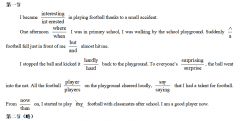河北正定中学2014届高三上学期第五次月考英语试题试卷(3)
Shopping for clothes is not the same experience for a man as it is for a woman. A man goes shopping because he needs something. His purpose is settled and decided in advance. He knows what he wants, and his objective is to find it and buy it; the price is a secondary consideration. All men simply walk into a shop and ask the assistant for what they want. If the shop has it in stock(有现货的), the salesman promptly produces it, and the business of trying it on follows at once. All being well, the deal can be and often is completed in less than five minutes, with hardly any chat and to everyone's satisfaction.
For a man, slight problems may begin when the shop does not have what he wants, or does not have exactly what he wants. In that case the salesman, as the name implies, tries to sell the customer something else, he offers the nearest to the article required. No good salesman brings out such a substitute impolitely; he does so with skill: “I know this jacket is not the style you want, sir, but would you like to try it for size? It happens to be the color you mentioned.” Few men have patience with this treatment, and the usual response is: “This is the right color and may be the right size, but I should be wasting my time and yours by trying it on.”
Now how does a woman go about buying clothes? In almost every respect she does so in the opposite way. Her shopping is not often based on need. She has never fully made up her mind what she wants, and she is only “having a look round”. She is always open to persuasion; indeed she sets great store by what the saleswoman tells her, even by what companions tell her. She will try on any number of things. Uppermost in her mind is the thought of finding something that everyone thinks suits her. Contrary to a lot of jokes, most women have an excellent sense of value when they buy clothes. They are always on the lookout for the unexpected bargain. Faced with a roomful of dresses, a woman may easily spend an hour going from one rail to another, to and fro, often retracing her steps, before selecting the dresses she wants to try on. It is a laborious process, but apparently an enjoyable one. Most dress shops provide chairs for the waiting husbands.
56. The underlined sentence “the price is a secondary consideration” in the first paragraph means when a man is shopping ______.
A. he buys good quality things, so long as they are not too dear
B. he buys whatever he likes without considering its value
C. he does not mind how much he has to pay for the right things
D. he often buys things without giving the matter proper thought.
57. According to the passage, what a man will do when he can not get exactly what he wants?
A. He will buy a similar thing because of the color he wants.
B. He will probably not buy anything.
C. At least two of his requirements must be met before he buys.
D. So long as the style is right, he will buy the thing.
58. What is the most obvious difference between men and women shoppers?
A. Men do not try clothes on in a shop while women do.
B. Women bargain for their clothes, but men do not.
C. The time they take over buying clothes.
D. Men go shopping based on need, but women never.
B
Chicken feathers are useful, and not just to a chicken. Some go into pillows, coats and other products. But countless chicken feathers go to waste.
In the United States, billions of chickens are produced yearly. Most of their feathers are thrown away.
But instead of being buried in land, some feathers could find a future in plastics.
One of the products they have developed is a flowerpot(花盆). It may look like other flowerpots. But the container breaks down in the earth within one to five years. And as it breaks down, it naturally becomes nutrient in the soil.
The environmentally friendly flowerpot is the work of two researchers. Walter Schmidt is with the Agricultural Research Service, part of the United States Agriculture Department. Masud Huda is with the Horticultural Research Institute, a private organization.
Walter Schmidt has been working to find uses for chicken feathers since the 1990s. Progress in 2002 showed that plastic made from feathers could be formed like other plastics.
He says feathers are much stronger and last longer than another plant material. "Feathers are stronger. By design, feathers are also more durable(耐用的). And the other part about it is if feathers were twice as heavy, or half as strong, then birds couldn't fly."
He points out that traditional flowerpots made from other plastics can last much longer. But he wonders if there is really a need. He says most flowerpots are never re-used.
"Why would you want a plastic that you use for a year to last for two hundred years? It makes no sense. You want to match the product with the use." said Walter Schmidt.
Walter Schmidt and Masud Huda are now adding another chicken product to their flowerpots —chicken waste. The waste will add more nutrients to the soil as the pot breaks down. The scientists say they hope their flowerpot will be on the market in a year or two.
59. What do people mainly deal with feathers?
A. Feathers are used to make pillows, coats and other products.
B. Most feathers are paid no attention to.
C. Most feathers are used as nutrient.
D. Most feathers are used to make flowerpots.
60. What’s the advantage of the flowerpots?
A. They won’t last long. B. They can’t break.
C. They are environmentally friendly. D. They can be reused.
61. What does Walter Schmidt think of traditional flowerpots?
A. Too heavy. B. Too old. C. Never re-used. D. Lasting longer but unnecessary.
62. What do you think is the main idea of the passage?
A. Chicken and its feathers. B. How to deal with feathers.




